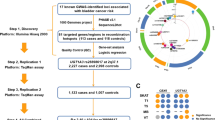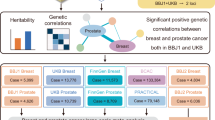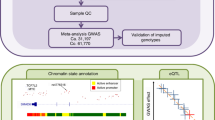Abstract
We conducted a multi-stage, genome-wide association study of bladder cancer with a primary scan of 591,637 SNPs in 3,532 affected individuals (cases) and 5,120 controls of European descent from five studies followed by a replication strategy, which included 8,382 cases and 48,275 controls from 16 studies. In a combined analysis, we identified three new regions associated with bladder cancer on chromosomes 22q13.1, 19q12 and 2q37.1: rs1014971, (P = 8 × 10−12) maps to a non-genic region of chromosome 22q13.1, rs8102137 (P = 2 × 10−11) on 19q12 maps to CCNE1 and rs11892031 (P = 1 × 10−7) maps to the UGT1A cluster on 2q37.1. We confirmed four previously identified genome-wide associations on chromosomes 3q28, 4p16.3, 8q24.21 and 8q24.3, validated previous candidate associations for the GSTM1 deletion (P = 4 × 10−11) and a tag SNP for NAT2 acetylation status (P = 4 × 10−11), and found interactions with smoking in both regions. Our findings on common variants associated with bladder cancer risk should provide new insights into the mechanisms of carcinogenesis.
This is a preview of subscription content, access via your institution
Access options
Subscribe to this journal
Receive 12 print issues and online access
$209.00 per year
only $17.42 per issue
Buy this article
- Purchase on Springer Link
- Instant access to full article PDF
Prices may be subject to local taxes which are calculated during checkout


Similar content being viewed by others
References
Silverman, D.T., Devesa, S.S., Moore, L.E. & Rothman, N. Bladder cancer. in Cancer Epidemiology and Prevention (eds. Schottenfeld, D. and Fraumeni, J.F. Jr.) 1101–1127 (Oxford University Press, New York, 2006).
Kantor, A.F., Hartge, P., Hoover, R.N. & Fraumeni, J.F. Jr. Familial and environmental interactions in bladder cancer risk. Int. J. Cancer 35, 703–706 (1985).
Murta-Nascimento, C. et al. Risk of bladder cancer associated with family history of cancer: do low-penetrance polymorphisms account for the increase in risk? Cancer Epidemiol. Biomarkers Prev. 16, 1595–1600 (2007).
Aben, K.K. et al. Segregation analysis of urothelial cell carcinoma. Eur. J. Cancer 42, 1428–1433 (2006).
Lower, G.M. Jr. et al. N-acetyltransferase phenotype and risk in urinary bladder cancer: approaches in molecular epidemiology. Preliminary results in Sweden and Denmark. Environ. Health Perspect. 29, 71–79 (1979).
Bell, D.A. et al. Genetic risk and carcinogen exposure: a common inherited defect of the carcinogen-metabolism gene glutathione S-transferase M1 (GSTM1) that increases susceptibility to bladder cancer. J. Natl. Cancer Inst. 85, 1159–1164 (1993).
García-Closas, M. et al. NAT2 slow acetylation, GSTM1 null genotype, and risk of bladder cancer: results from the Spanish Bladder Cancer Study and meta-analyses. Lancet 366, 649–659 (2005).
Rothman, N., Garcia-Closas, M. & Hein, D.W. Commentary: Reflections on G.M. Lower and colleagues' 1979 study associating slow acetylator phenotype with urinary bladder cancer: meta-analysis, historical refinements of the hypothesis, and lessons learned. Int. J. Epidemiol. 36, 23–28 (2007).
Kiemeney, L.A. et al. Sequence variant on 8q24 confers susceptibility to urinary bladder cancer. Nat. Genet. 40, 1307–1312 (2008).
Kiemeney, L.A. et al. A sequence variant at 4p16.3 confers susceptibility to urinary bladder cancer. Nat. Genet. 42, 415–419 (2010).
Wu, X. et al. Genetic variation in the prostate stem cell antigen gene PSCA confers susceptibility to urinary bladder cancer. Nat. Genet. 41, 991–995 (2009).
Eeles, R.A. et al. Identification of seven new prostate cancer susceptibility loci through a genome-wide association study. Nat. Genet. 41, 1116–1121 (2009).
Yeager, M. et al. Identification of a new prostate cancer susceptibility locus on chromosome 8q24. Nat. Genet. 41, 1055–1057 (2009).
Crowther-Swanepoel, D. et al. Common variants at 2q37.3, 8q24.21, 15q21.3 and 16q24.1 influence chronic lymphocytic leukemia risk. Nat. Genet. 42, 132–136 (2010).
Tomlinson, I.P. et al. A genome-wide association study identifies colorectal cancer susceptibility loci on chromosomes 10p14 and 8q23.3. Nat. Genet. 40, 623–630 (2008).
Easton, D.F. et al. Genome-wide association study identifies novel breast cancer susceptibility loci. Nature 447, 1087–1093 (2007).
Zanke, B.W. et al. Genome-wide association scan identifies a colorectal cancer susceptibility locus on chromosome 8q24. Nat. Genet. 39, 989–994 (2007).
Yeager, M. et al. Genome-wide association study of prostate cancer identifies a second risk locus at 8q24. Nat. Genet. 39, 645–649 (2007).
Rafnar, T. et al. Sequence variants at the TERT-CLPTM1L locus associate with many cancer types. Nat. Genet. 41, 221–227 (2009).
Stacey, S.N. et al. New common variants affecting susceptibility to basal cell carcinoma. Nat. Genet. 41, 909–914 (2009).
Landi, M.T. et al. A genome-wide association study of lung cancer identifies a region of chromosome 5p15 associated with risk for adenocarcinoma. Am. J. Hum. Genet. 85, 679–691 (2009).
Shete, S. et al. Genome-wide association study identifies five susceptibility loci for glioma. Nat. Genet. 41, 899–904 (2009).
Petersen, G.M. et al. A genome-wide association study identifies pancreatic cancer susceptibility loci on chromosomes 13q22.1, 1q32.1 and 5p15.33. Nat. Genet. 42, 224–228 (2010).
Freedman, M.L. et al. Assessing the impact of population stratification on genetic association studies. Nat. Genet. 36, 388–393 (2004).
Wellcome Trust Case Control Consortium. Genome-wide association study of 14,000 cases of seven common diseases and 3,000 shared controls. Nature 447, 661–678 (2007).
García-Closas, M. et al. A single nucleotide polymorphism identified in a genome-wide scan tags variation in the N-acetyltransferase 2 phenotype in populations of European background. Pharmacogenet. Genomics published online, doi:10.1097/FPC.0b013e32833e1b54 (25 August 2010).
Conticello, S.G. The AID/APOBEC family of nucleic acid mutators. Genome Biol. 9, 229 (2008).
Malumbres, M. & Barbacid, M. To cycle or not to cycle: a critical decision in cancer. Nat. Rev. Cancer 1, 222–231 (2001).
Richter, J. et al. High-throughput tissue microarray analysis of cyclin E gene amplification and overexpression in urinary bladder cancer. Am. J. Pathol. 157, 787–794 (2000).
Strassburg, C.P., Lankisch, T.O., Manns, M.P. & Ehmer, U. Family 1 uridine-5′-diphosphate glucuronosyltransferases (UGT1A): from Gilbert's syndrome to genetic organization and variability. Arch. Toxicol. 82, 415–433 (2008).
Ando, Y. et al. Polymorphisms of UDP-glucuronosyltransferase gene and irinotecan toxicity: a pharmacogenetic analysis. Cancer Res. 60, 6921–6926 (2000).
Strassburg, C.P., Manns, M.P. & Tukey, R.H. Differential down-regulation of the UDP-glucuronosyltransferase 1A locus is an early event in human liver and biliary cancer. Cancer Res. 57, 2979–2985 (1997).
Strassburg, C.P., Nguyen, N., Manns, M.P. & Tukey, R.H. Polymorphic expression of the UDP-glucuronosyltransferase UGT1A gene locus in human gastric epithelium. Mol. Pharmacol. 54, 647–654 (1998).
Giuliani, L. et al. Can down-regulation of UDP-glucuronosyltransferases in the urinary bladder tissue impact the risk of chemical carcinogenesis? Int. J. Cancer 91, 141–143 (2001).
Iida, K. et al. Suppression of AhR signaling pathway is associated with the down-regulation of UDP-glucuronosyltransferases during BBN-induced urinary bladder carcinogenesis in mice. J. Biochem. 147, 353–360 (2010).
Calado, R.T. & Young, N.S. Telomere maintenance and human bone marrow failure. Blood 111, 4446–4455 (2008).
Armanios, M.Y. et al. Telomerase mutations in families with idiopathic pulmonary fibrosis. N. Engl. J. Med. 356, 1317–1326 (2007).
Tsakiri, K.D. et al. Adult-onset pulmonary fibrosis caused by mutations in telomerase. Proc. Natl. Acad. Sci. USA 104, 7552–7557 (2007).
Calado, R.T. et al. Constitutional hypomorphic telomerase mutations in patients with acute myeloid leukemia. Proc. Natl. Acad. Sci. USA 106, 1187–1192 (2009).
Park, J.H. et al. Estimation of effect size distribution from genome-wide association studies and implications for future discoveries. Nat. Genet. 42, 570–575 (2010).
Hein, D.W. N-acetyltransferase 2 genetic polymorphism: effects of carcinogen and haplotype on urinary bladder cancer risk. Oncogene 25, 1649–1658 (2006).
Wigginton, J.E., Cutler, D.J. & Abecasis, G.R. A note on exact tests of Hardy-Weinberg equilibrium. Am. J. Hum. Genet. 76, 887–893 (2005).
Pritchard, J.K., Stephens, M. & Donnelly, P. Inference of population structure using multilocus genotype data. Genetics 155, 945–959 (2000).
Frazer, K.A. et al. A second generation human haplotype map of over 3.1 million SNPs. Nature 449, 851–861 (2007).
Price, A.L. et al. Principal components analysis corrects for stratification in genome-wide association studies. Nat. Genet. 38, 904–909 (2006).
Patterson, N., Price, A.L. & Reich, D. Population structure and eigenanalysis. PLoS Genet. 2, e190 (2006).
Yu, K. et al. Population substructure and control selection in genome-wide association studies. PLoS ONE 3, e2551 (2008).
de Bakker, P.I. et al. Practical aspects of imputation-driven meta-analysis of genome-wide association studies. Hum. Mol. Genet. 17, R122–R128 (2008).
Sun, L., Wilder, K. & McPeek, M.S. Enhanced pedigree error detection. Hum. Hered. 54, 99–110 (2002).
Clayton, D. Testing for association on the X chromosome. Biostatistics 9, 593–600 (2008).
Fearnhead, P. SequenceLDhot: detecting recombination hotspots. Bioinformatics 22, 3061–3066 (2006).
Fearnhead, P., Harding, R.M., Schneider, J.A., Myers, S. & Donnelly, P. Application of coalescent methods to reveal fine-scale rate variation and recombination hotspots. Genetics 167, 2067–2081 (2004).
Acknowledgements
The bladder cancer GWAS was supported by the intramural research program of the US National Institutes of Health, National Cancer Institute.
This project has been funded in part with federal funds from the National Cancer Institute, US National Institutes of Health, under Contract No. HHSN261200800001E. The content of this publication does not necessarily reflect the views or policies of the Department of Health and Human Services, nor does mention of trade names, commercial products or organizations imply endorsement by the US Government.
Please see Supplementary Note for information on support for individual studies that participated in the effort.
Author information
Authors and Affiliations
Contributions
N.R., M.G.-C., N.C., J.D.F., D.T.S. and S.J.C. organized and designed the study.S.J.C., K.B.J., A.H., Z.W., Y.-P.F., .L.P.-O., L.B., X.W., M.A.T.H., M.C., D.V.D.B., S.G., S.P., R.R.M., I.D.V., T.R., D.T.B., G.C.-T., J.G.H., R.K., S.C.E.B. and A.G. conducted and supervised genotyping of samples.
M.G.-C., N.C., N.R., K.B.J., M.Y., N.M., D.T.S. and S.J.C. contributed to the design and execution of statistical analysis.
M.G.-C., N.R., N.C., N.M., J.D.F., F.X.R., J.F.F., D.T.S. and S.J.C. wrote the first draft of the manuscript.N.R., M.G.-C., N.M., X.W., J.D.F., F.X.R., D.V.D.B., F.X.R., G.M., D.B., M.T., L.A.K., P.V., I.D.V., D.A., M.P.P., T.R., M.A.T.H., A.E.K., O.C., K.G., R.K., J.A.T., J.I.M., M.K., A.T., C.S., A.C., R.G.-C., J.L., A.J., M.S., M.R.K., A.S., G.A., R.G., A.B., E.J.J., W.R.D., S.M.G., S.J.W., J.V., V.K.C., M.G.-D., M.C.P., M.C.S., J.-M.Y., D.J.H., M.M., C.P.D., B.C., M.C., H.Y., S.H.V., K.K.A., J.A.W., R.R.M., P.S., S.B., K.S., E.R., P.B., S.P., C.N., N.E.A., H.B.B., D.T., N.C., M.T.L., F.C., B.L., A.T., F.C.-C., D.T.B., M.T.W.T., M.A.K., S.G., S.P., F.R., C.S., A.A., G.C.-T., S.S., J.G.H., H.D., T.F., P.R., E.G., K.K., S.C.E.B., A.G., Z.X., J.I.S.-V., M.D.G.-P., M.S., G.V., S.P., S.B., R.N.H., J.F.F., D.T.S. and S.J.C. conducted the epidemiologic studies and contributed samples to the bladder cancer GWAS and/or replication.
All authors contributed to the writing of the manuscript.
Corresponding author
Ethics declarations
Competing interests
The authors declare no competing financial interests.
Supplementary information
Supplementary Text and Figures
Supplementary Figures 1–7, Supplementary Tables 1–4 and Supplementary Note (PDF 4458 kb)
Rights and permissions
About this article
Cite this article
Rothman, N., Garcia-Closas, M., Chatterjee, N. et al. A multi-stage genome-wide association study of bladder cancer identifies multiple susceptibility loci. Nat Genet 42, 978–984 (2010). https://doi.org/10.1038/ng.687
Received:
Accepted:
Published:
Issue Date:
DOI: https://doi.org/10.1038/ng.687



